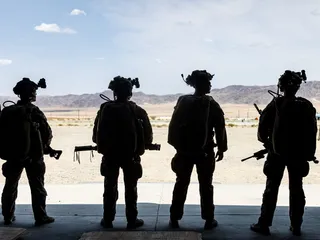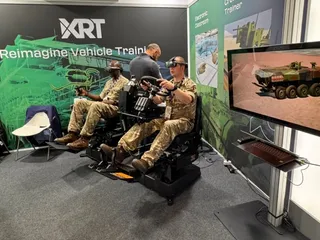Analysis: Showing the US Military Simulation and Training Community the Money
Contact Our Team
For more information about how Halldale can add value to your marketing and promotional campaigns or to discuss event exhibitor and sponsorship opportunities, contact our team to find out more
The Americas -
holly.foster@halldale.com
Rest of World -
jeremy@halldale.com

This remains a most unconventional year inside the Washington, DC Beltway. While traditionally the White House delivers its next fiscal year budget proposal to Congress in the third week of February, the Trump administration has incrementally sent its Fiscal Year 2026 budget documents to the US Congress through this summer. With partial spending proposals starting to arrive on Capitol Hill this June, the comprehensive Defense Budget Overview, United States Department of Defense Fiscal Year 2026 Budget Request was finally released this July and made available for public viewing this month. The document contains important S&T investments across the Pentagon’s portfolio. A number of these funding decisions will build partner capacity around the globe and will help deliver future-leaning training and exercise systems that will be relevant well beyond this budget’s outyears.
This article analyzes and comments on randomly selected S&T funding requests in the Pentagon’s FY26 budget.
Expand Multi-Domain Training, Strengthen Joint Training
The budget request highlights the administration’s understanding of S&T’s value in advancing the skill sets of individuals, units and staffs, and the linkage of those readiness underpinnings to multi-domain operations and, by extension, joint missions.
One representative section noted the Air Force continues to invest in operational training infrastructure in the USINDOPACOM theater to enhance operational readiness in efforts to counter the US’s pacing challenge. Accordingly, “Development of the synthetic training environment infrastructure, focusing on the Joint Simulation Environment, is necessary to train for the challenges of future combat operations. This funding will assist in upgrading critical training ability to outpace potential adversary threat environments and improve training integration of 4th and 5th-generation aircraft.” Further focusing on the imperative for multi-domain operations training in the context of a joint mission is the declaration the JSE is expanding beyond its original use for F-35 synthetic environment testing to an all-domain pacing threat readiness environment for the Joint Force. Enter the Joint Integrated Training Center, noted to be “a government-owned center operating the JSE, mitigating the air combat training lag challenge and filling fidelity gaps by co-locating simulator bays of tier-one assets (F-35, F-22, Next Generation Air Dominance, EA-18G, B-21, E-7, E-2D, AEGIS, Patriot, THAAD, HIMARS, Space, and Cyber) in a single facility.” JITCs are planned in USINDOPACOM and USEUCOM.
Just when the author was ready to call out the Pentagon for a perceived flagging training readiness effort in the cyber domain, the FY26 budget document noted the Pentagon remains committed to expanding the force’s cyber training competencies. The Persistent Cyber Training Environment will be the DoD’s primary cyberspace operations training and certification source. The FY26 budget allows the program to advance to the end of Phase II, at which point PCTE will support end-to-end (individual to-collective) training for the full range of cyberspace forces, both Cyberspace Operations Forces and non-COF.
Indo-Pacific Focus
Supporting the Trump Administration’s policy focus on Indo-Pacific, the FY 2026 Pacific Deterrence Initiative request of $10.0 billion includes a $3.4 billion investment for exercises, training, experimentation and innovation. One development on our watch list is USINDOPACOM’s evolving Pacific Multi-Domain Training and Experimentation Capability, designed to provide the ability to train the joint force, allies and partners via linkages between ranges. The budget document noted, “PMTEC will form the world’s largest, fully instrumented coalition range system with the most advanced capabilities for virtualization, simulation, and operational rehearsal over long distances via integrated joint live, virtual, and constructive training.” We look forward to more fully updating the community on PMTEC’s expansion beyond its early developments.
Within the US Services’ Training Lifelines
The FY26 budget request will move resources below the joint and combined levels to individual service and agency programs.
Four representative, service-level funding intentions include:
- $13.4 billion for Army home-station training for ground maneuver forces and $3.0 billion for aviation readiness;
- support for the Navy’s intent to “train for combat as we plan to fight, in the real world and virtually.”;
- the Marine Corps’ $0.8 billion investment in FY 2026 in support of its service-level training installations to ensure Marines are properly trained to address all warfighting functions across the range of military operations; and
- US Space Force’s budget request for its readiness accounts, an increase of 14.9 percent above the FY 2025 enacted levels, with resources for advanced training and other purposes.
One Red Flag
MS&T supports gaining efficiencies in the federal budget through streamlining headquarters, consolidating commands and such – when it makes sense. Accordingly, we remain opposed to the Pentagon’s intentions to “merge the US Army Training and Doctrine Command (TRADOC) with Army Futures Command (AFC), to increase agility and efficiency across all echelons.” AFC with its Synthetic Training Environment CFT, has been the land-service’s one focal point to help advance this force into the future. The merger would detract the Army’s efforts to coherently move beyond this decade.
A Wider View
A complete view of the S&T aspects in the FY26 DoD Budget request may be obtained here.


